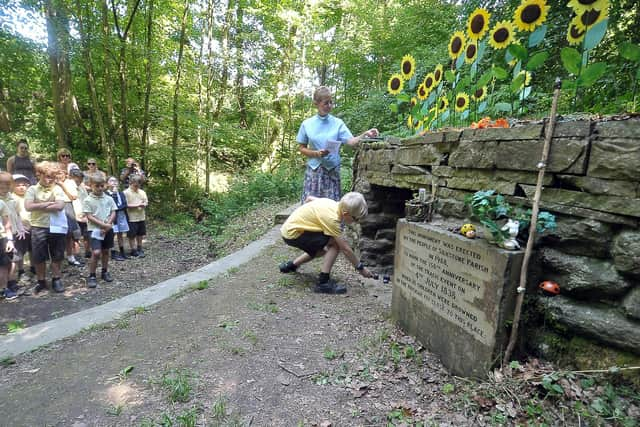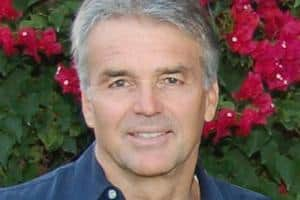Huskar and Oaks pit disasters: California author puts Barnsley ancestors into novel Out of the Darkness
Having authored his first book, Christmas Kindling, a 2018 collection of stories inspired by true events, the San Diego man’s late mother wanted to hear them.
“She lived in the eastern part of the United States, about 3,000 miles away, so she asked if I would read her some of the stories because she had gone blind with her cancer and macular degeneration and not being in her area I hopped on a plane and flew to Louisiana and I sat down with her,” says David, speaking during a trip to Park City, Utah.
Advertisement
Hide AdAdvertisement
Hide Ad“The first day we read a couple of stories out of this book, Christmas Kindling, and then over the next eight days, I read her the entire book, and she told me about her history. I didn’t know anything about this history before because she was born and grew up an orphan, and didn’t really tell me anything about the family that she had that was in Wyoming.


“Turns out that this family has a tremendous history in the UK. I spent the next two and a half years researching the history of the family. It’s my great-great grandparents and Thomas Wright, the main character in Out of the Darkness, started as a child coal miner in Silkstone.”
The name might sound familiar because of a disaster on July 4, 1838 at Huskar pit outside the village of Silkstone Common, Barnsley – one related to the new novel David mentions, his family history and our labour laws.
Twenty-six children, reportedly between seven and 17, died when a violent thunderstorm sent torrents of floodwater into the pit.
Advertisement
Hide AdAdvertisement
Hide AdThomas Wright went to work there aged seven in 1837 and was injured in, but survived, the disaster the year after.


Much of the public outcry about the situation was driven by mothers of the children. Thomas’s mother, Martha, joined others in the community in pushing for a change to child labour laws.
A Royal Commission set up after the disaster led to The Mines Act, which banned boys under 10 and girls (and women) of any age from working underground in 1842.
While the people and events in Out of the Darkness are real, David decided on a novel using fictional dialogue, interpersonal relations, and some literary licence, because he wanted their lives and plight to be relatable. The book is split into three parts, the first of which relates to Thomas’s childhood.
Advertisement
Hide AdAdvertisement
Hide AdDavid, a father to four and grandfather to 13, says: “When I was writing about Thomas in the mine, at age seven, I paid particular attention to one of my very bright grandchildren who was age seven at the time, and could read, and is now older and is very successful in school.
“So I tried to imagine what it would be like for that grandchild at age seven, to go into a mine working six days a week, 12 hours a day, not seeing the sun except on Sundays.
“What it would be like to be in a mine where it’s so dark, he couldn’t even see his hand in front of his face. They didn’t even give them one single candle to do their work. He was a trapper to start out with and he opened and closed doors in these small little chambers, sometimes as small as two-and-a-half feet by two feet, or three feet, for these children to climb through and dig and drag coal back and forth from one place to another,” he says.
“So a lot of the book is about the emotional challenges that this child had to deal with. When would he cry? When would he be scared? When would he learn to adjust? His only friends at the time, most of the time, were the rats that lived in those mines, some of them were almost as big as him…”
Advertisement
Hide AdAdvertisement
Hide AdWhen he grew up, Thomas worked at the nearby Oaks Colliery at Hoyle Mill.
It was the site of England’s worst mining disaster on December 12-13, 1866, when it is believed some 383 men and boys were killed after explosions caused by firedamp or gas.
“In the end, the inquest decided that it was, frankly, an act of God and not much could be done and the owners of the mines, who were incredibly wealthy, were obligated to pay absolutely nothing,” says David, 73, who worked as an engineer.
However, the press relayed the horrors of the disaster to the public, who were outraged.
Advertisement
Hide AdAdvertisement
Hide AdIn the year after playing a role in the inquest, chronicling deaths that occurred, Thomas with his wife Annie in 1868 moved to America. After working on the transcontinental railroad to its completion, they settled in the Wyoming territory, close to Park City in Utah, where David has discovered cousins through his research and book publication.
His second book in what he has called the Courageous Series, Where Eagles Fly Free, will focus on events that followed their migration and is due out next year.
Back in England, it took Parliament six years to pass the Coal Mines Regulation Act of 1872. The law introduced the requirement for pit managers to have state certification of their training and miners were also given the right to appoint inspectors from among themselves. David’s family link to the disasters and following campaigns has made him feel connected to the land of his ancestors, and grateful to meet new relatives.
He says: “I basically retired from the life I lived – I never would have had the time to do this when I was working full-time, but in this particular second life, it’s been a fascinating journey.”
Out of the Darkness, published by Forefront Books, is out now.